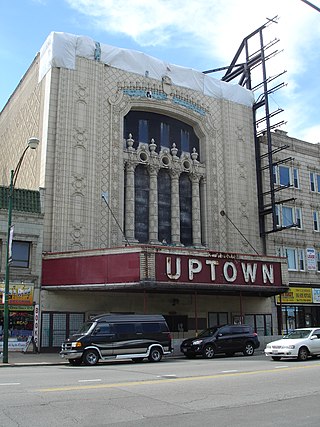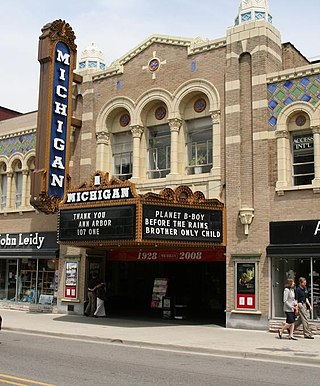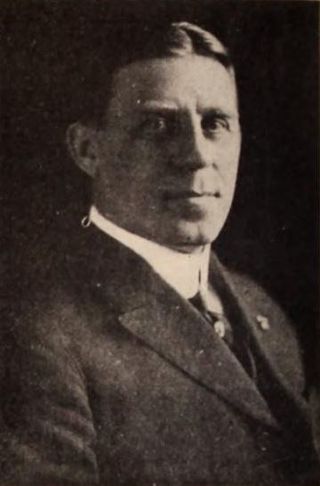
The Tennessee Theatre is a movie palace in downtown Knoxville, Tennessee. The theater was built in 1928 in the 1908 Burwell Building, considered Knoxville's first skyscraper. The theater and Burwell Building were added to the National Register of Historic Places in 1982, and the theater was extensively restored in the early 2000s. The Tennessee Theatre currently focuses on hosting performing arts events and classic films, and is home to the Knoxville Opera and the Knoxville Symphony Orchestra. The theater is managed by AC Entertainment.

A movie palace is any of the large, elaborately decorated movie theaters built between the 1910s and the 1940s. The late 1920s saw the peak of the movie palace, with hundreds opening every year between 1925 and 1930. With the advent of television, movie attendance dropped, while the rising popularity of large multiplex chains in the 1980s and 1990s signaled the obsolescence of single-screen theaters. Many movie palaces were razed or converted into multiple-screen venues or performing arts centers, though some have undergone restoration and reopened to the public as historic buildings.

The Fox Theatre is a performing arts center located at 2211 Woodward Avenue in Downtown Detroit, Michigan, near the Grand Circus Park Historic District. Opened in 1928 as a flagship movie palace in the Fox Theatres chain, it was at over 5,000 seats the largest theater in the city. Designed by theater architect C. Howard Crane, it was listed on the National Register of Historic Places in 1985.

The Michigan Theater is a movie palace in Ann Arbor, Michigan, United States, near the Central Campus of the University of Michigan. It shows independent films and stage productions, and hosts musical concerts.

The Fox Theatre, a former movie palace, is a performing arts center located at 527 N. Grand Blvd. in St. Louis, Missouri, United States. Also known as "The Fabulous Fox", it is situated in the arts district of the Grand Center area in Midtown St. Louis, one block north of Saint Louis University. It opened in 1929 and was completely restored in 1982.

The Coronado Performing Arts Center, in Rockford, Illinois, is a 2,400-seat theatre, designed by architect Frederic J. Klein. The theatre cost $1.5 million to build, and opened on October 9, 1927.

The Fox Oakland Theatre is a 2,800-seat concert hall, a former movie theater, located at 1807 Telegraph Avenue in Downtown Oakland. It originally opened in 1928, running films until 1970. Designed by Weeks and Day, the theatre is listed on the National Register of Historic Places. It was refurbished in the 2000s and reopened as a concert venue on February 5, 2009.

Peery's Egyptian Theater is a movie palace located in Ogden, Utah, United States. It was added to the National Register of Historic Places in 1978.

The Gillioz Theatre is a historic theater located at Springfield, Missouri, United States. It was built by M. E. Gillioz of Monett, Missouri. Mr. Gillioz was in the business of building bridges, and the theater was built with steel and concrete. Wood was only used for handrails, doors, and doorframes. The original cost of the building was $300,000. Renovation costs totaled approximately $1.9 million.

Saenger Theatre is an atmospheric theatre in downtown New Orleans, Louisiana, which is on the National Register of Historic Places. Once the flagship of Julian and Abe Saenger's theatre empire, today it is one of only a handful of Saenger movie palaces that remain.
George Washington Trendle was an American lawyer and businessman, best known as the producer of the Lone Ranger radio and television programs along with The Green Hornet and Sergeant Preston of the Yukon.

John H. Kunsky (1875–1952) was a Detroit area businessman who made his fortune by investing in movie theaters. He later became partners with George W. Trendle and invested in radio.

An atmospheric theatre is a type of movie palace design which was popular in the late 1920s. Atmospheric theatres were designed and decorated to evoke the feeling of a particular time and place for patrons, through the use of projectors, architectural elements and ornamentation that evoked a sense of being outdoors. This was intended to make the patron a more active participant in the setting.

The Hamasa Shrine Temple Theater, added to the National Register of Historic Places in 1979, is a historic theater located at 2320 8th Street in Meridian, Mississippi. The Temple Theater was constructed in the Moorish Revival style and began screening silent films in 1928. The theater features a Byzantine motif, a swirl of marble fountains, and large bronze chandeliers. At the time of its construction, the theater contained one of the largest stages in the United States, second only to the Roxy Theater in New York City. The theater houses one of only two Robert Morton theatre organs still installed in their original locations in the State of Mississippi – the other being installed at the Saenger Theater in Hattiesburg, Mississippi. Both organs are under the care and restoration efforts of the Magnolia Chapter of the American Theatre Organ Society (ATOS).

The Alger Theater is a theatre located at 16451 East Warren Avenue in the MorningSide neighborhood of Detroit, Michigan. It is one of only two remaining intact and unchanged neighborhood theaters in the city of Detroit. It was listed on the National Register of Historic Places in 2005.

The Historic Ironwood Theatre is a theatre in Ironwood, Michigan offering a variety of live theatrical, musical, and artistic performances as part of its programming. The theatre is a non-profit entertainment establishment owned by the City of Ironwood and operated by Ironwood Theatre Inc., a non-profit organization led by volunteers who serve on the board of directors.
The performing arts in Detroit include orchestra, live music, and theater, with more than a dozen performing arts venues. The stages and old time film palaces are generally located along Woodward Avenue, the city's central thoroughfare, in the Downtown, Midtown, and New Center areas. Some additional venues are located in neighborhood areas of the city. Many of the city's significant historic theaters have been revitalized.

The Capitol Theatre Building is a cinema and concert venue located at 140 E. 2nd St. in Flint, Michigan. Designed by John Eberson, it is an atmospheric theater designed to look like a Roman garden. The Capitol Theatre opened in 1928, and operated as a cinema and live performance venue until 1996. The theatre was listed on the National Register of Historic Places in 1985.

The State Theatre is a Spanish-styled atmospheric theatre in Kalamazoo, Michigan, designed by renowned architect John Eberson. The State was built for W.S. Butterfield Theatres in 1927, and remains in operation today, presenting live shows. The theatre was listed on the National Register of Historic Places in 2021.

The Senate Theater is a theater in Detroit, Michigan, known for its "Mighty Wurlitzer" pipe organ, originally installed at the Fisher Theater. The Senate opened in 1926, deteriorated substantially after its closure in the 1950s, and reopened in 1964 under the ownership and volunteer operation of the Detroit Theatre Organ Society. The Senate continues to present organ performances, classic films, and private events.



























